
If you’ve just had braces or Invisalign and you want to know whether you can mew with your retainer, this guide is for you. The frustration of having to still keep wearing a device even after you’ve completed your treatment is understandable, but you don’t want to jump into mewing too quickly.
A limited amount of mewing with retainers might be possible. But taking your retainer out is a bad idea since most people cannot mew perfectly 24/7. But taking the retainer out at some point and replacing it with mewing is possible if your mewing technique is good enough and your doctor approves.
Whether you can take your retainer out or whether you should mew with it depends a lot on the type of retainer you have, and your proficiency with mewing.
Purpose of a Retainer
A retainer is meant to protect your teeth from relapsing to their old position after you have finished your treatment with Invisalign or braces. In general, the retainer should be worn for as long as you had your braces in, or even longer.
A mold of your mouth is taken and a device is made for you to wear to ensure that your teeth stay aligned. A retainer can also be used to train your tongue, prevent teeth from drifting back, subtly align your teeth further, fix teeth grinding, and fix tongue thrusting which leads to open bite.
The alveolar bone in which the teeth are located has one of the highest bone remodeling rates in the body. But even then, it takes a long time for it to adapt to your new teeth position. You actually have holes in your jaw until it hardens around your new teeth. For your teeth to stay in their new position, bone has to be removed from one side (resorbed) and then deposited to lock your teeth into their new area. This process can take at least 9 to 12 months.
But it’s not just the bone that matters. You also have ligaments and muscles that are used to your old tooth position. When your retainer is out, this musculature wants to go back to its old configuration and literally constricts your teeth and dental arch to their old position. This is why you have to be really careful if you’re considering taking out your retainer.
Retainer Mewing Tips
The retainer locks your teeth in place so they don’t relapse. But the danger comes when you only wear it at night and you mew during the day. While you mew during the day, you push your teeth forward. But at night, the retainer snaps the teeth back into place. Essentially, you’re wiggling the teeth around like a steak in the ground. This damages your teeth in the long term and prevents the bone from depositing correctly.
As a result, your mewing technique should change a little bit. First and foremost, remember not to push on your actual teeth. We’re trying to lock them in place, so touching/pushing them is the last thing we want to do right now.
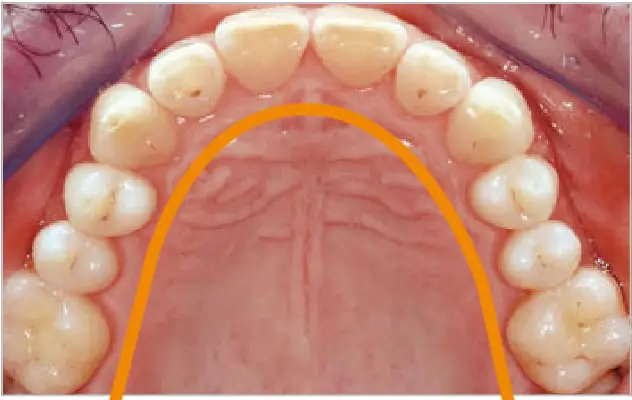
With normal mewing, you’re pushing upwards but also on the sides of your dental arch to get them to expand:
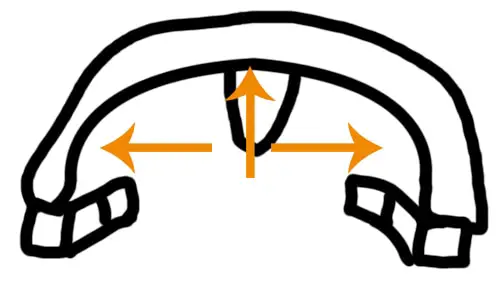
With a retainer in, you don’t want to push on the sides of the dental arch at all. Palatal expansion is no longer our goal. What we want is forward growth and facial upswing. That can be accomplished by squishing the tongue horizontally and making sure our tongue is only touching the top of the roof our mouth, creating an upward force. Do not actively push or hard mew. Do not touch your teeth with your tongue.
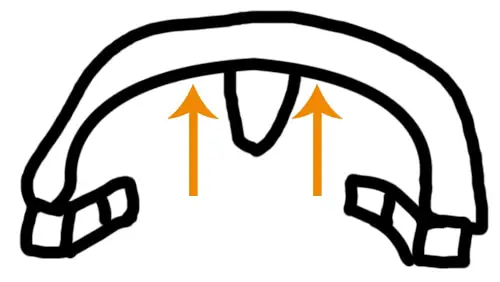
By mewing this way, we’re letting the retainer do its job, but we’re also fixing our posture, getting good at mewing, and optimizing forward growth. All this is going to be a huge help when you finally take the retainer out. When that time comes, you want to be mewing as much as possible and as well as you can. It takes time to build up and train your nerves/muscles, so you need to get a head start on it.
Use this technique with extreme caution though. If you notice discomfort after putting on your retainers, quit mewing. If you notice your tongue hitting your teeth, quit mewing. Do not apply any force and most certainly don’t hard mew. However, merely having proper oral posture while having your retainers in isn’t dangerous and isn’t going to magically make your teeth fall out.
Some people say that the retainer is going to counteract any mewing progress. This stems from the misunderstanding of the fact that palatal expansion and forward growth are not the same things. Yes, the retainer is locking your teeth in place and preventing the palate from getting bigger. But you can still get forward growth and facial upswing without expanding your palate. The teeth and facial bones are separate.
You don’t need to work on your palate width while the retainer does its job. Plus, if your palate is too small even after braces/Invisalign, what was the point of your treatment? Go back to the drawing board and actually expand your palate. A narrow palate will hamper your mewing gains. Otherwise, you can afford to optimize your bite and give time for your teeth to adjust. Spend your time building up proper mewing habits and optimizing your forward growth and facial upswing as the retainer does its job.
Finish your treatment, but still, get all the benefits of mewing at the same time.
Mewing With an Essix Retainer
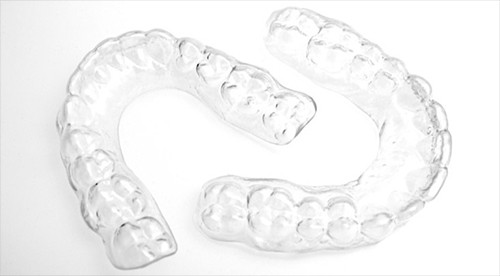
An Essix retainer is a clear retainer that snaps to your teeth and looks much like an Invisalign aligner. These are easy to mew with because they only cover the teeth and don’t block your tongue. You can mew as normal with this retainer, and it will even warn you when your tongue is too close to your front teeth. If you find that your tongue keeps getting cut up on the retainer, apply some orthodontic gel to it. This will make it easier and you will get used to it.
Mewing With a Hawley Retainer
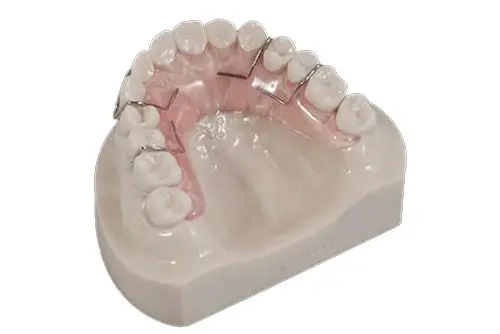
A Hawley retainer is terrible for mewing as it takes up tongue space on the upper palate. If you have a Hawley retainer, I suggest going back to your orthodontist/dentist and asking for an Essix retained or a fixed retainer.
Mewing With a Fixed Retainer
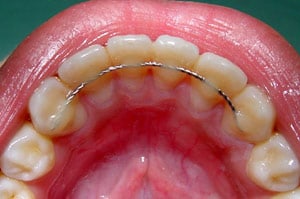
A fixed retainer only locks the front 4 or 6 teeth, depending on what your dentist or orthodontist feels is appropriate. It avoids any damage to soft tissues unlike the fixed retainers, but the failure rate is slightly higher because you’re not getting all the teeth.
Mewing with one of these is easy because it takes up so little space and doesn’t actually lock your back teeth in. However, your mewing technique really has to be on point with this. Be sure that you’re ready to work really hard at mewing so that your palate doesn’t get smaller.
The Bottom Teeth
Unfortunately, the tongue cannot be used to expand the bottom teeth. Usually, the bottom teeth follow the upper teeth with normal growth. But if you have to wear a retainer you might not be so lucky. If you ever end up taking your retainer out from your upper palate, I suggest still leaving the bottom one in. The tongue cannot be used to help your bottom teeth and they most likely will relapse.
The best retainer for the lower teeth is the Hawley retainer. It doesn’t take up as much space as the Hawley retainer for the upper teeth or even the Essix retainer.
The Likelihood Of Relapse
If you have a retainer, then you’re most likely worried about the likelihood of your teeth relapsing to their original position. But the thing about relapse is that it’s probably coming anyway. Not even half of patients maintain their teeth alignment over a period of 10 years. After 20 years, the retention rate is only around 10%.
Our results suggest that occlusal relapse can be expected after active orthodontic treatment irrespective of long-term use of fixed retainers.
These results would indicate that you need to focus on mewing and proper oral posture in order to maintain your gains. The fact that most people don’t is probably the root cause of relapse. Remember, the best palatal expander is the tongue.
If you’re told to wear your retainer for your entire life, I would question that. At some point, the tongue and muscles of your face should be ready to step up and do the work instead of you having to rely on the retainer your whole life.
A 19-year-old patient had his overbite corrected orthodontically:
Treatment of the patient with molar intrusion using temporary skeletal anchorage was initially successful, but the anterior open-bite reoccurred during the retention period due to a persistent low tongue posture.
Unfortunately after 3 years, his anterior open bite relapsed to its normal position due to his poor oral posture. However, after being outfitted with a device that forced him to keep the tongue on the roof of his mouth, the patient did not experience any relapse in symptoms even after a 10-year follow-up. His facial aesthetics also improved.

While mewing can’t replace devices that work 24/7, it’s possible that training your oral posture might allow for removal of the retainer, as long as your provider approves.
Should I Remove My Retainer?
Removing your retainer is a risk. The bones and the ligaments in your mouth need time to adapt. No amount of mewing will help you if your very own body is working against you 24/7.
My suggestion is to finish the treatment with the retainer. A good time frame is to wear it for slightly longer than you wore your braces. That way you can work on your oral posture and body posture while the retainer is doing its job. Get really good at mewing so that when the time comes to take the retainer out, you obliterate any chances of relapse.
However, bear in mind that your success with preventing relapse will only be as good as your mewing technique. Are you mewing 24/7? Are you waking up with your tongue on the roof of your mouth? Is your tongue always on the roof of your mouth? If so, you might consider taking the retainer out early.
The earliest I would risk taking the retainer out is probably a year into it. But if you’re not absolutely sure your mewing technique is perfect and that you’re mewing every second you’re awake, then I would hesitate. To be safe, don’t take the retainer out until 18 months.
If you want, you could experiment and see how good your tongue posture is. Try taking your Essix retainer out while mewing as well as you can. If you notice the retainer getting tighter next time you try it on, you’re relapsing and should probably put it back on.
Not Enough Tongue Space With Retainer
If you don’t have enough tongue space to mew with your retainer, you need to go back to the drawing board. Get palatal expansion or MSE and then finish your treatment with the retainer.
You won’t be able to mew properly without adequate tongue space anyway. Sure, if you fixed your crooked teeth that’s nice, but until you have enough room to fully engage your tongue on your palate without hitting your teeth, your work isn’t done.
The best option is the Maxillary Skeletal Expander (MSE). Unlike regular palatal expanders, it doesn’t move teeth. Moving teeth has very limited mileage because not only does the bone have to adapt but there’s a limited amount that you can move the teeth in adults. Move the teeth too much and they will become wobbly and unstable.
The MSE splits the midpalatal suture in half near the back of the face:
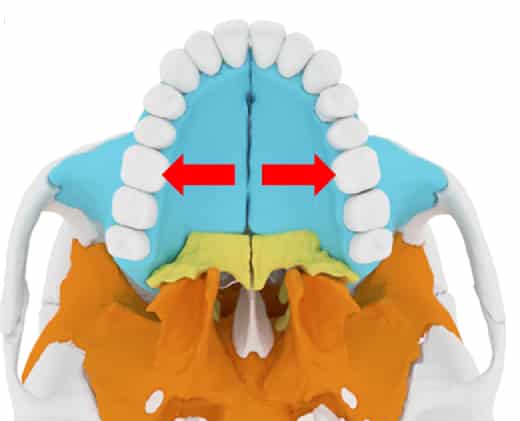
This will give you true bone-borne palatal expansion that far outdoes what braces or Invisalign can do for you.
However, the procedure is painful. The device literally gets screwed into your maxilla from the bottom of your mouth and splits your skull in half. You do get used to it after several weeks, but it’s an ordeal that comes with its own risks such as asymmetrical expansion, failure to split the suture, and screw-drag.
But if you’re an adult, this is one of your only options to get true change. You might also require MSDO to widen your lower jaw to go along with it. Talk with your doctor to see if this would be a good option for you.
Which Retainer Is Best For Mewing?
The best retainer for you is something that should be determined by your doctor. But in general, the best retainer for mewing is the fixed retainer, since only the front teeth are locked and you’re not potentially rocking the teeth back and forth by switching between mewing and the retainer every day.
You can get all the benefits of mewing with the fixed retainer, but your front teeth (which determine your smile), can’t move out of place. However, if your oral posture hasn’t been developed enough, this retainer might be counterproductive and you’re better off getting the Essix retainer.
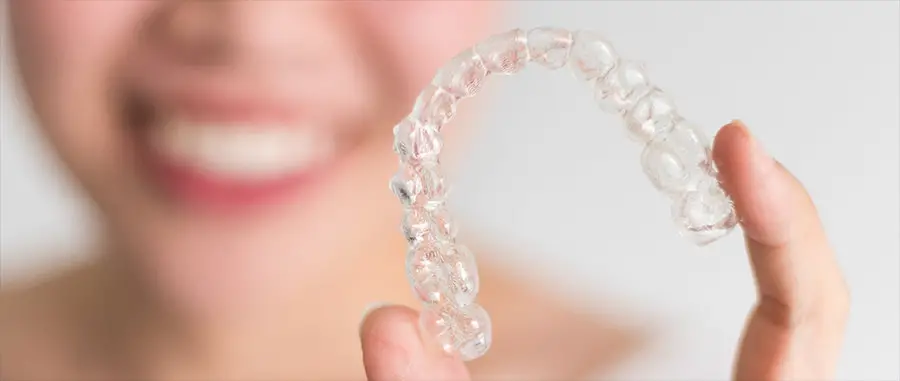
The Essix retainer however will do the best job of locking your teeth in place and preventing relapse, should you wear it all the time. You can still mew with this retainer but should be careful to not press near your teeth.
The Hawley retainer is generally bad for mewing, and you should aim to replace it with something else. However, for the bottom teeth, the Hawley retainer is the best because it takes up the least room.
How To Ensure My Teeth Don’t Relapse
The ability of the teeth to relapse to their old position just depends on whether your face and muscles can support your new bone position. The more you moved your teeth, the more likely you are to relapse.
One strategy you have is to wear the Essix retainer for 6 months, and then move on to a fixed retainer of the front 4 or 6 teeth, while trying to work extremely hard at mewing.
If you expand with a bone-borne appliance like an MSE, you will get a minimal relapse of the teeth. The biggest key to ensuring your teeth don’t relapse is to work on your mewing technique, namely to make sure you’re doing it 24/7 and doing it correctly.
Make sure to visit our Ultimate Mewing Guide for more mewing tips.
If your main goal is significant palatal expansion, you should seriously consider the MSE.
The most important thing is finishing your treatment. Make sure you mew as much as you can while you wear the retainer so that when you take it off, your oral posture can support your teeth without the aid of the retainer. The retainer is just training wheels. Again, don’t actively press while you mew with a retainer, as that’s where the danger lies.
Wear the retainer for at least a year and when you take it off, make sure you test whether your teeth are moving back. If your teeth are moving back, your oral posture needs more work.


